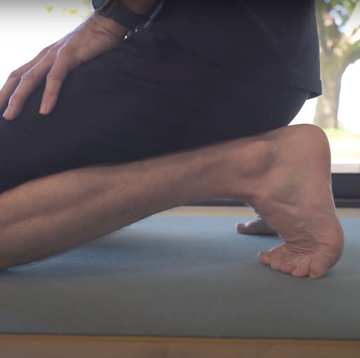THE SCIATIC NERVE is the longest nerve in the body, branching from your lower back through your hips and buttocks and down each leg into the foot. The nerve passes between the muscles, joints, ligaments, tendons and other structures.
This passage can be tortuous, and tightness and restriction can affect the nerve and thus its function. Think of it as a hosepipe – the tap (the brain) sends the message but a kink in the pipe can impede its flow. Issues with the sciatic nerve can cause weakness and lack of activation in the glutes, hamstrings, calf and foot. It’s a niggly tightness – you know you are not firing fully when running but can’t get rid of the problem.
Sometimes the result is sharp pain, when the bones or discs in the spine press on the nerve. But subtler restrictions can cause weakness and inactivity in specific muscles or muscle groups, and might occur only when the muscles are working hard, such as when you run. You might feel it as a recurrent weakness or imbalance further down the leg.
Test your sciatic nerve mobility
This is called the slump test. Sit with your head on your chest and your arms behind your back. Next, slump forward through your trunk as low as you can.
A: Best winter running gear.
B: You will feel the tightness build – don’t force this pull but note where the tightness is located. You will probably feel the pull in the back of your knee and your lower hamstring. However, we are all different. Do the move on both legs and note the differences: This can be location – for example, you might feel tightness more in the glute than the hamstring, or even the lower back or calf.
It might be that you feel the pull begins at an earlier part of the knee extension.
Once you identify the location of the restriction and the point at which it starts, take the leg to this point and then lift just your head up toward the ceiling. This should release the tension almost completely. Again, compare left and right.
Improve your sciatic nerve mobility
A restriction in the spinal area may be an indication of a specific issue. If you feel spinal pain or pull, you should get assessed by a physiotherapist.
The aim with all the moves below is to gently restore parity between your legs when you perform the slump test. In general, the pull location tallies with the feeling of restriction. However, it does not always follow as neatly as this. If that is the case, try other points and see what happens.
The final test is to see how you feel when you are running. If your running power and control improve, you know you have made some useful changes. Keep working on the restriction points for a couple of weeks. However, if the symptoms persist or return, then you should get assessed by your physio to look for underlying issues in your back.
Restriction is felt in the calf
Sit on the floor with your affected leg out straight in front of you and a small, hard ball (a tennis ball will do) under the calf of that leg, and find the tender spot. Next, rest your other leg on your shin and press down.
Pull the foot and toes of the affected leg toward you. When your foot is fully up, drop your chin to your chest and lean forward, waiting for the tightness (pull) to ease as you go.
Restriction is felt in the hamstring
Sit on a firm seat and place a tennis ball, or harder, under the leg at the point of the pull. Wriggle around on the ball until you find the tender spot and sit on it until it eases.
Then slowly straighten the knee, waiting each time the pull returns until it eases. Once you have straightened the leg fully, lean forward into the slump position, repeating the ‘wait until it eases’ process as you go.
Restriction is felt in the glutes
Put the affected leg’s foot across the opposite leg and bring your knee up to your chest, holding that leg at the back of the knee for support. Place the ball under the glute at the point of the tightness.
Next, lean over the ball until you can feel the tightness in the glute. As with the other moves, wait until the tightness eases and continue, slowly extending the knee out as straight as you comfortably can.
Ben is Runner's World's Multiplatform Director and has worked at the title for over 11 years. He has always had a deep interest in running shoes and tech and has amassed a wealth of knowledge on running products during this time and through countless hours of testing. Ben also enjoys exploring the science behind running and how it informs advances in training and racing. He is also the co-host of the weekly podcast. Ben is a firm believer that running is just as much about adventure and fun as about chasing PBs, and he likes nothing more than a day spent explore new trails.

















